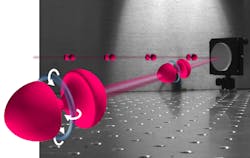Laser 'smoke rings' have potential for communications and microscopy
University of Maryland (College Park, MD) physicists have discovered that powerful laser beams, given the right conditions, will act as their own lenses and "self-focus" into a tighter, even more intense beam and can also generate violent swirls of optical energy that strongly resemble smoke rings. In these donut-shaped light structures or vortices, the light energy flows through the inside of the ring and then loops back around the outside. The researchers named the laser smoke rings "spatiotemporal optical vortices," or STOVs.
The vortices travel along with the laser pulse at the speed of light and control the energy flow around it. The team strongly suspects that STOVs could explain decades' worth of anomalous results and unexplained effects in the field of high-intensity laser research. The newly discovered optical structures are described in the journal Physical Review X.
RELATED ARTICLE: Ultrafast-laser-written glass polarization converter inexpensively creates optical vortices
"Lasers have been researched for decades, but it turns out that STOVs were under our noses the whole time," said Howard Milchberg, professor of physics and electrical and computer engineering at UMD and senior author of the research paper, who also has an appointment at the UMD Institute for Research in Electronics and Applied Physics (IREAP). "This is a robust, spontaneous feature that's always there. This phenomenon underlies so much that's been done in our field for the past 30-some years."
More conventional spatial optical vortices are well-known from prior research--chief among them "orbital angular momentum" (OAM) vortices, where light energy circulates around the beam propagation direction much like water rotates around a drain as it empties from a washbasin. Because these vortices can influence the shape of the central beam, they have proven useful for advanced applications such as high-resolution microscopy.
"Conventional optical vortices have been studied since the late 1990s as a way to improve telecommunications, microscopy and other applications. These vortices allow you to control what gets illuminated and what doesn't, by creating small structures in the light itself," said the paper's lead author Nihal Jhajj, a physics graduate student who conducted the research at IREAP.
"The smoke ring vortices we discovered may have even broader applications than previously known optical vortices, because they are time dynamic, meaning that they move along with the beam instead of remaining stationary," Jhajj added. "This means that the rings may be useful for manipulating particles moving near the speed of light."
Eventually, STOVs might have useful real-world applications, like their more conventional counterparts. For example, OAM vortices have been used in the design of more powerful stimulated emission depletion (STED) microscopes. STED microscopes are capable of much higher resolution than traditional confocal microscopes, in part due to the precise illumination offered by optical vortices. With the potential to travel with the central beam at the speed of light, STOVs could have as-yet unforeseen advantages in technological applications, including the potential to expand the effective bandwidth of fiber-optic communication lines.
"A STOV is not just a spectator to the laser beam, like an angel's halo," explained Milchberg, noting the ability of STOVs to control the central beam's shape and energy flow. "It is more like an electrified angel's halo, with energy shooting back and forth between the halo and the angel’s head. We're all very excited to see where this discovery will take us in the future."
SOURCE: University of Maryland; http://www.umdrightnow.umd.edu/news/umd-physicists-discover-laser-light-smoke-rings
About the Author

Gail Overton
Senior Editor (2004-2020)
Gail has more than 30 years of engineering, marketing, product management, and editorial experience in the photonics and optical communications industry. Before joining the staff at Laser Focus World in 2004, she held many product management and product marketing roles in the fiber-optics industry, most notably at Hughes (El Segundo, CA), GTE Labs (Waltham, MA), Corning (Corning, NY), Photon Kinetics (Beaverton, OR), and Newport Corporation (Irvine, CA). During her marketing career, Gail published articles in WDM Solutions and Sensors magazine and traveled internationally to conduct product and sales training. Gail received her BS degree in physics, with an emphasis in optics, from San Diego State University in San Diego, CA in May 1986.
